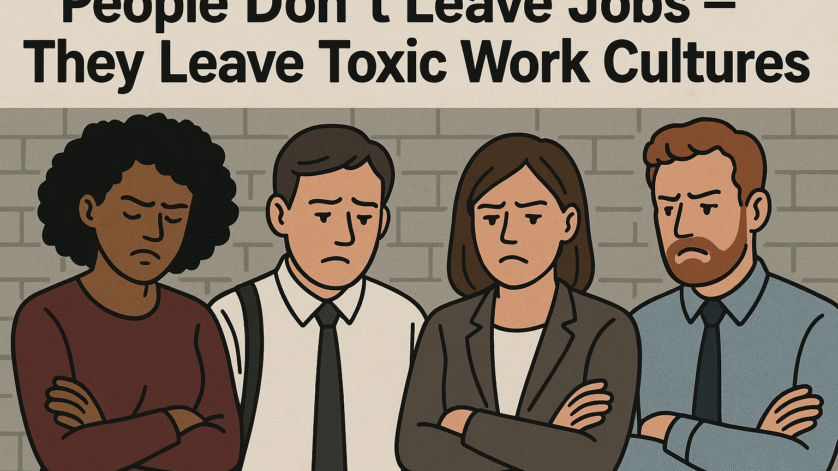🧠 Introduction: Why Employees Quit Isn’t What You Think
In today’s evolving remote-first work environment, employers are quick to analyze roles, pay scales, or job descriptions when employees leave. But the real reason often lies beyond the job itself:
People don’t leave jobs—they leave toxic work cultures.
Especially in remote teams, where face-to-face interaction is rare, work culture becomes everything. When it’s broken, even your most loyal team members won’t stay.
🚩 9 Red Flags of a Toxic Work Culture
Toxic culture isn’t always loud or obvious. It creeps in quietly, but the damage is massive.
Here are 9 warning signs that your work environment may be pushing people away:
- Favoritism – When certain employees are treated better than others, resentment grows.
- Bad Managers – A lack of leadership skills or empathy makes people feel unsupported.
- Lack of Support – Team members feel isolated, especially in remote settings.
- Weak Leadership – No clear direction leads to confusion and frustration.
- Toxic Team Members – A single negative personality can disrupt the entire team.
- Unfair Treatment – Inequality in promotions, pay, or workloads leads to high attrition.
- Micromanagement – Constant checking signals a lack of trust.
- Poor Pay – Underpaying top talent is the fastest way to lose them.
- No Growth Opportunities – When employees don’t see a future, they create one elsewhere.
💼 The Impact of Toxic Work Culture on Remote Jobs
For remote companies, cultural health is even more critical.
When you don’t see your team in person:
- Tension isn’t visible.
- Burnout isn’t voiced.
- Disengagement gets masked by silence.
Without a supportive, open, and fair environment, remote employees feel abandoned — and eventually, they disconnect or resign.
🔍 Employee Turnover Is a Culture Problem, Not a Talent Problem
When your best employees leave, it’s easy to blame external factors:
- Better offers
- More benefits
- Changing priorities
But look inward. High turnover is often a symptom of poor internal culture.
💬 According to a LinkedIn study, 70% of professionals quit their job due to cultural mismatch or poor management, not money.
🔧 How Leaders Can Build a Healthier Work Culture (Even Remotely)
The good news? Culture can be fixed. But it starts at the top.
Here are actionable steps:
✔️ 1. Lead with Fairness and Accountability
Ensure policies apply to everyone equally. No exceptions, no favorites.
✔️ 2. Train Your Managers
Not everyone is born a leader. Offer coaching, communication training, and emotional intelligence programs.
✔️ 3. Address Toxic Behavior Directly
Ignoring it is enabling it. Have tough conversations and protect team morale.
✔️ 4. Invest in Growth Opportunities
Offer skill-building workshops, learning budgets, and career pathways. People stay where they grow.
✔️ 5. Pay Competitively
Compensate fairly for talent and loyalty. It’s cheaper to retain a skilled employee than hire a new one.
✔️ 6. Trust Your Team
Empower, don’t micromanage. Autonomy boosts confidence and performance.
✔️ 7. Encourage Feedback Loops
Create a safe space for team members to share concerns or suggestions. Anonymous feedback tools work well in remote teams.
✔️ 8. Celebrate Wins and Effort
Even small victories deserve recognition. It builds motivation and belonging.
💬 Real-World Example: What Happens When Culture Improves
A mid-size SaaS company switched from reactive management to proactive culture-building.
Within 6 months:
- Their employee retention rate improved by 35%
- 2 of their best performers who planned to quit decided to stay
- Productivity rose by 28%, and so did revenue
The secret? They didn’t change the job — they transformed the environment.
📢 Final Thoughts
Your team isn’t just working for a paycheck — they’re investing their energy, creativity, and time.
If they feel unheard, unsupported, or mistreated, they won’t stay—regardless of perks or job titles.
So if your organization is struggling with retention, take a hard look at the work culture.

